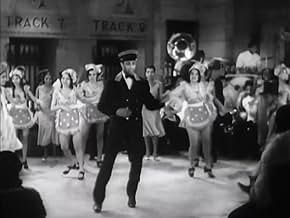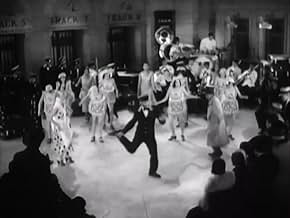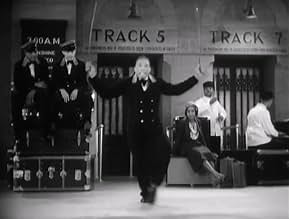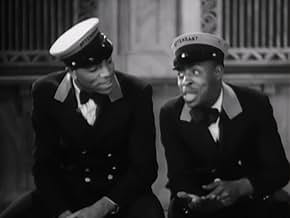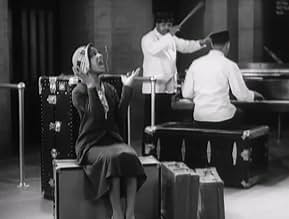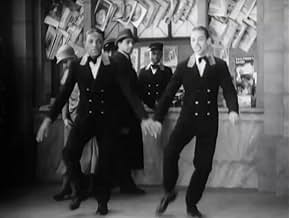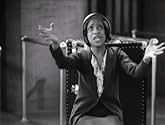A group of redcaps in a train station perform musical numbers to raise money for a sick member of their group.A group of redcaps in a train station perform musical numbers to raise money for a sick member of their group.A group of redcaps in a train station perform musical numbers to raise money for a sick member of their group.
- Director
- Writers
- Stars
Wayman Carver
- Entertainer
- (uncredited)
Sidney Catlett
- Drummer
- (uncredited)
Leonard Davis
- Entertainer
- (uncredited)
Roy Eldridge
- Trumpeter
- (uncredited)
Dick Fulbright
- Entertainer
- (uncredited)
Otto Hardwick
- Entertainer
- (uncredited)
Rod Harlan
- Entertainer
- (uncredited)
Don Kirkpatrick
- Entertainer
- (uncredited)
Carrie Marrier
- Entertainer
- (uncredited)
Lew Payton
- Lodge Member
- (uncredited)
Doris Rubboton
- Entertainer
- (uncredited)
Mabel Scott
- Vocalist
- (uncredited)
Al Sears
- Saxophonist
- (uncredited)
Elmer Snowden
- Band Leader
- (uncredited)
Emmett 'Babe' Wallace
- Entertainer
- (uncredited)
George Washington
- Trombonist
- (uncredited)
Dicky Wells
- Trombonist
- (uncredited)
- Director
- Writers
- All cast & crew
- Production, box office & more at IMDbPro
Featured reviews
While Mabel Scott IS in the movie, she's NOT the singer, who's much too old. (Mabel would have been 17 at the time.) About 3 minutes into the film, there's the beginning of a dance sequence, in which Mabel Scott is the lead dancer; she's the only one wearing a black blouse. While mostly remembered as a singer today, Mabel Scott started her career, around 1930, as both a dancer and a singer. It's possible that the singer is Doris Rheubottom, who would have been around 33 at the time, but the singer looks even older than that. Otherwise, it's a wonderful movie and really highlights the great entertainment that Smalls Paradise offered.
Train station attendants gather to raise money for a disabled brother. Others join in. This a singing and dancing short with a group of negro performers. The most interesting is tap dancing that evolves into something akin to break-dancing. It's too bad that i don't know any of these performers. Cinema owes it to them to make them into real stars. Small's Paradise should be much better known.
I've just started collecting black short films, you'll have a hard time finding them or trying to catch it on Turner Classic Movies but when you find it, it'll be worth it. Great singing and dancing, but what I hate is the fact that they don't introduce themselves or call their names, because you'll wanna know who some of these people are and you'll wanna see more of their work or you've seen them in other films or shorts, but you'll find out who they are in due time. This is great because it just gives you an idea of what was in and what they were doing in that era, the latest dancing and singing. Great fun.
Redcaps and porters put on a jazz show in Grand Central Station -- eastern upper level, to judge by the track numbers on display -- in this all-Black short.
The cast is listed as "Small's Paradise Entertainers" and that's quite likely. Small's Paradise was one of the leading Harlem clubs in the 1920s and 1930s, like the better remembered Cotton Club. It was opened in 1925 by Ed Small and was the only well-known Harlem night spot with a Black owner. Over the decades, many great entertainers performed for its integrated audiences. It passed through at least three owners, all black, and in its last years was owned by Wilt Chamberlain, and performed as a combination discotheque and performance space. By the time it finally closed in 1986, it was the longest-running Jazz club in Harlem.
Lots of hot jazz and dancing in this short.
The cast is listed as "Small's Paradise Entertainers" and that's quite likely. Small's Paradise was one of the leading Harlem clubs in the 1920s and 1930s, like the better remembered Cotton Club. It was opened in 1925 by Ed Small and was the only well-known Harlem night spot with a Black owner. Over the decades, many great entertainers performed for its integrated audiences. It passed through at least three owners, all black, and in its last years was owned by Wilt Chamberlain, and performed as a combination discotheque and performance space. By the time it finally closed in 1986, it was the longest-running Jazz club in Harlem.
Lots of hot jazz and dancing in this short.
This is a short film from Vitaphone. Oddly, while most of Hollywood had no place for blacks in films except to be servants or comic relief, Warner Brothers featured quite a few black acts in their Vitaphone shorts--thus allowing us to preserve this part of our history.
"Smash Your Baggage" is has an all-black cast and although the film has a few derogatory stereotypes (such as the porters using up their funds shooting dice), it has a positive message that can be enjoyed by all. Because they have no funds in their relief fund, the porters decide to put on a benefit the next day. What follows has very little plot but LOTS of make the film fun--crazy good dancing. First, there are two of the most amazingly athletic tap dancers you'll ever see. You just have to see them to believe them--and some of what they do looks almost like break dancing fused with tap. The guy who jumps rope and taps was also pretty amazing. About the only flat moment was the lady balladeer. This isn't entirely her fault--as there was an issue with the quality of the sound. The bottom line is that this film features some amazing stuff--so amazing you can understand why today there's such nostalgia for the Harlem Renaissance of the 1920s and 30s.
"Smash Your Baggage" is has an all-black cast and although the film has a few derogatory stereotypes (such as the porters using up their funds shooting dice), it has a positive message that can be enjoyed by all. Because they have no funds in their relief fund, the porters decide to put on a benefit the next day. What follows has very little plot but LOTS of make the film fun--crazy good dancing. First, there are two of the most amazingly athletic tap dancers you'll ever see. You just have to see them to believe them--and some of what they do looks almost like break dancing fused with tap. The guy who jumps rope and taps was also pretty amazing. About the only flat moment was the lady balladeer. This isn't entirely her fault--as there was an issue with the quality of the sound. The bottom line is that this film features some amazing stuff--so amazing you can understand why today there's such nostalgia for the Harlem Renaissance of the 1920s and 30s.
Did you know
- TriviaAccording to the book "Jazz on Film and Video" in the Library of Congress, "Identified musicians include Wayman Carver, Sidney Catlett, Leonard Davis, Roy Eldridge (predating his recording career by four years), Dick Fulbright, Otto Hardwick, Rod Harlan, Don Kirkpatrick, Al Sears, Elmer Snowden (his only film appearance), George Washington, and Dicky Wells."
- Quotes
Redcap Attendant #1: I call this special meetin' of the Benevolent Protection Society to order. The Black Knights of the Redcaps has resolved, where is, to wit!
Redcap Attendant #2: I moves to second that emotion.
- ConnectionsFeatured in Added Attractions: The Hollywood Shorts Story (2002)
- SoundtracksTiger Rag
(uncredited)
Music by Edwin B. Edwards, Nick LaRocca, Tony Sbarbaro, Henry Ragas and Larry Shields
Performed by Small's Paradise Entertainers
Details
- Release date
- Country of origin
- Language
- Also known as
- Melody Masters (1932-1933 season) #3: Smash Your Baggage
- Production company
- See more company credits at IMDbPro
- Runtime
- 10m
- Color
- Sound mix
Contribute to this page
Suggest an edit or add missing content

